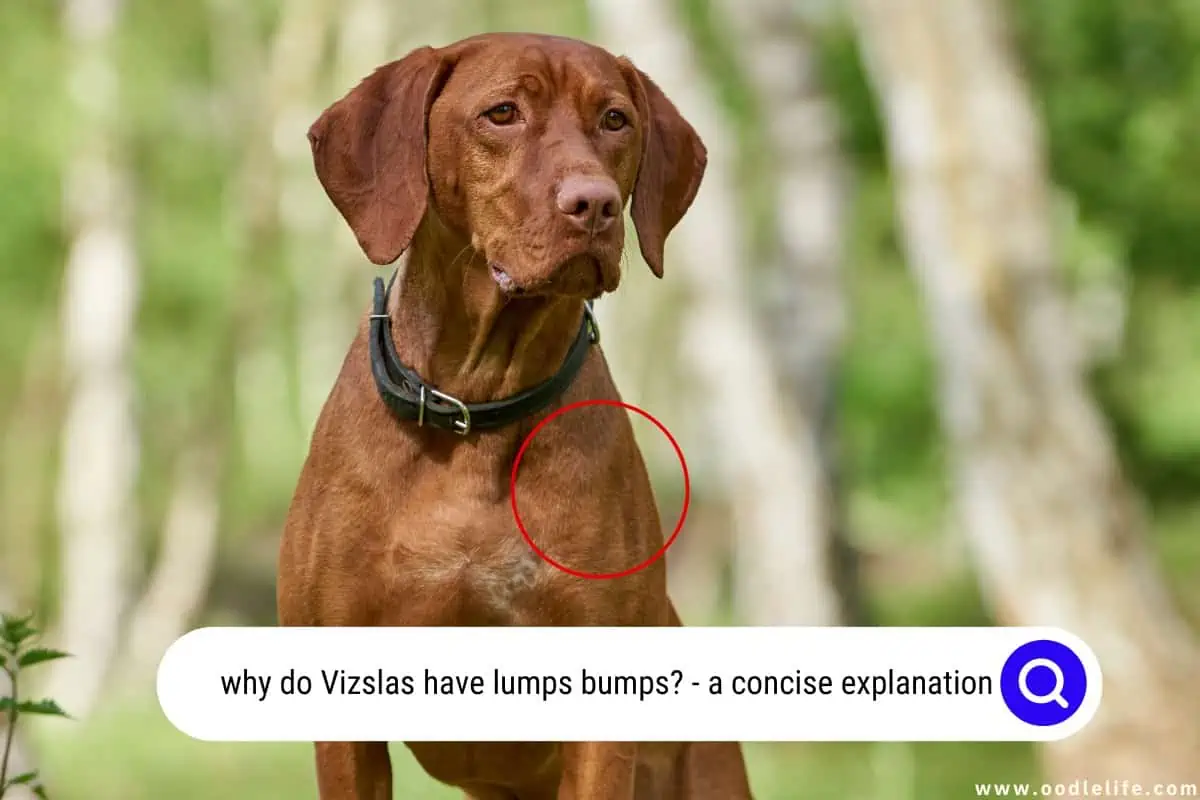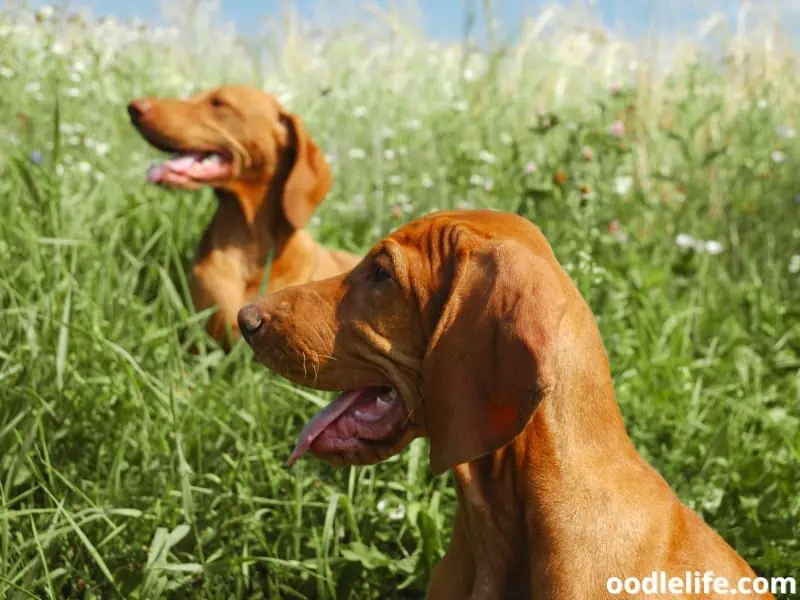7 Weird Reasons that Vizslas Have Lumps and Bumps
Vizslas, a stunning and affectionate dog breed, are known for their sleek, rust-colored coat and energetic personalities. Sometimes, however, owners may notice lumps or bumps on their beloved canine companion’s skin. While it’s natural to be concerned about these growths, it’s essential to understand that various factors may cause them.
Common lumps and bumps on Vizslas could include benign skin growths, such as lipomas or sebaceous cysts. These are usually harmless and do not require immediate medical attention. On the other hand, they may also develop allergies or infections, which can cause bumps or lesions on their skin.

In any case, it’s crucial for pet owners to monitor their Vizsla’s skin regularly and consult with a veterinarian if they observe any changes.
Some humor to lighten the mood: Remember, our furry friends can’t tell us what’s bugging them, so it’s up to us to keep an eye on their lumps and bumps. Don’t be surprised if your Vizsla gives you a confused look when you start feeling their skin for any oddities, but it’s all in the name of their health and happiness!
Why Do Vizslas Develop Lumps and Bumps?
Vizslas, just like any other dog breed, can develop lumps and bumps on their skin for various reasons. In this section, we’ll discuss some of the natural causes and health conditions that could lead to these skin abnormalities in Vizslas.

Natural Causes
Some bumps and lumps on a Vizsla’s skin may be completely normal and harmless, a result of their natural skin growth or minor injuries. For example, small bumps could be just hair follicles or sebaceous glands. In addition, Vizslas play and interact with their environment, making them susceptible to insect bites, scratches, or even small harmless cysts formed due to mild skin irritations.
While it’s important to monitor any changes in your Vizsla’s skin, these natural causes usually don’t pose significant health risks and often resolve on their own without treatment.
Health Conditions
On the other hand, some lumps and bumps could be signs of health issues that need more attention. One such condition is lipomas, which are soft fatty tumors that often grow just underneath the skin. According to The Healthy Pet Manual, lipomas are common in dogs, and while generally harmless, some can grow and cause discomfort or restrict movement.
Another health concern to consider is skin allergies. Vizslas, like other dog breeds, can develop allergies to food or environmental irritants. This can result in skin inflammation, leading to bumps, redness, and itching.
Lastly, it’s essential to be aware of the possibility of cancerous tumors. Although relatively rare, it’s crucial to consult your veterinarian if you notice any new, rapidly growing, or irregularly shaped lumps on your Vizsla’s skin.
To ensure your Vizsla remains healthy, regularly check their skin for changes and consult a vet when any new or concerning growths appear. It’s always better to err on the side of caution when it comes to your furry friend’s health.
Types of Lumps and Bumps
Vizslas, like other dog breeds, can develop various types of lumps and bumps on their skin. While some of these growths may be harmless, it’s essential to monitor them for any changes. In this section, we’ll discuss four common types of lumps and bumps: Fatty Tumors, Skin Tags, Cysts, and Warts.

Fatty Tumors
Fatty tumors, or lipomas, are soft, round growths that form beneath the skin. These non-cancerous tumors consist primarily of fat cells and are typically harmless. In Vizslas, lipomas might feel like a squishy lump that easily moves under your gentle touch.
Keep an eye on fatty tumors, but don’t worry too much – they’re the canine equivalent of that extra cookie you snuck in last night!
Skin Tags
Skin tags are small, fleshy growths that protrude from the skin. They’re generally benign and can grow anywhere on a Vizsla’s body, though they tend to appear around the neck, chest, and armpit areas. Skin tags are like that one lazy friend who’s always hanging around – they might not be the most attractive, but they’re probably not causing any harm!
Cysts
Cysts are fluid-filled sacs that can develop under a Vizsla’s skin. They might feel like a firm, round lump and can vary in size. Though they usually don’t pose any significant health risks, cysts can sometimes become infected or rupture.
It’s essential to keep an eye on these uninvited visitors, much like that one neighbor who always shows up unannounced!
Warts
Lastly, we have warts – those pesky, rough-textured growths that can occur anywhere on a Vizsla’s skin. Warts are typically caused by a virus, and though they might appear unsightly, they’re generally harmless. It’s like your dog’s telling you, “Hey, don’t look at me – I didn’t put these here!”
Seeing a lump or bump on your Vizsla can be concerning, but understanding the different types can help ease the worry. In any case, if you notice a new growth or changes in size, shape or texture, it’s best to consult with your veterinarian. Keep in mind, not all lumps are troublemakers – some are just along for the ride!
Diagnosis and Evaluation
When it comes to Vizslas and their lumps or bumps, it’s essential to have a proper diagnosis and evaluation. These abnormalities might be harmless, but it’s crucial to identify the cause and determine whether they need intervention.

To begin the diagnostic process, a veterinarian will typically conduct a thorough physical examination, checking for the size, shape, and location of the lump or bump. Visual assessment and palpation give initial information to guide the evaluation. Additionally, the vet would take into account the dog’s age, breed, and medical history since breeds like Vizslas are prone to specific issues.
Next, the veterinarian may opt to perform diagnostic tests such as fine-needle aspiration or biopsy. These tests involve taking a sample of cells from the lump or bump and analyzing them under a microscope. This analysis can provide further insight into the nature of the lump and help determine whether it’s benign or malignant.
Some lumps and bumps can be associated with thyroid issues, for which it is necessary to perform proper evaluation. The Canine Thyroid Epidemic underscores the importance of accurate screening to ensure the best treatment plan for every dog.
Remember, early detection is key when dealing with lumps, bumps, and any other health concerns. Make it a habit to regularly check your Vizslas for any changes in their skin and coat. If you find anything suspicious, it’s always best to consult your veterinarian, who can evaluate the situation and provide guidance accordingly.
In conclusion, while not all lumps and bumps in Vizslas are a cause for concern, routine check-ups, proper diagnosis, and prompt evaluation can help ensure your furry friend stays happy and healthy.
Treatment and Management
Surgical Removal
In some cases, lumps and bumps in Vizslas may require surgical removal by a veterinarian. This often depends on the nature of the lump and its potential to impact the dog’s health. For example, if the lump is suspected to be cancerous, or if it is growing and causing discomfort, surgical intervention might be necessary.
It is crucial for pet owners to consult with their veterinarian to determine if surgery is the best course of action for their Vizsla.
For minor lumps, like lipomas or benign fatty tumors, a veterinarian might opt for a less invasive technique such as a fine needle aspiration, where fluid is removed using a syringe. This procedure can help ease pressure and discomfort but may not completely remove the lump.
Home Care
Dog owners can also implement some home care strategies to address and manage lumps and bumps in their Vizslas. Keeping an eye on the size, location, and appearance of any lumps can help in informing the veterinarian about any changes or concerns.
If the lumps are due to allergies or skin irritations, pet owners can take steps to identify and eliminate the cause of the irritation. Ensuring the dog’s environment is clean and free of potential allergens, as well as maintaining a healthy diet, can help alleviate symptoms. Additionally, the use of hypoallergenic shampoos and conditioners during bath time may help improve the skin’s condition.
In cases where the bumps are due to minor injuries or insect bites, it is essential to gently clean the affected area with warm water and a mild antiseptic solution. Ensure that the dog doesn’t scratch or bite the area, which could worsen the condition or lead to an infection.
By combining proper veterinary care with vigilant home care, Vizsla owners can take steps to mitigate the impact of lumps and bumps on their beloved pets’ well-being.
Prevention and Care
Preventing and caring for lumps and bumps on a Vizsla involves several steps, including regular checkups, proper grooming, and maintaining a healthy diet. By following these guidelines, owners can better ensure the health and comfort of their canine companions.

Regular Check-Ups
Scheduling regular check-ups with a veterinarian is crucial for early detection and treatment of any potential health concerns. During these visits, the vet will examine your Vizsla for any lumps or bumps that may have developed, and can recommend appropriate treatment or preventative measures.
Proper Grooming
A well-groomed Vizsla is a happy Vizsla! Proper grooming is essential in maintaining your dog’s overall skin health. Regularly brushing your Vizsla helps to remove dirt, debris, and loose hair that might lead to matting and potential skin irritation.
Additionally, routinely checking for any new lumps, bumps, or skin changes allows you to promptly address these concerns with a vet.
Maintaining a Healthy Diet
Feeding your Vizsla a healthy diet is an important aspect of prevention. A balanced diet, rich in essential nutrients, can help support your Vizsla’s skin health, immune system, and overall wellbeing. Be sure to consult with your veterinarian for guidance on the most appropriate diet for your dog’s specific needs.
In short, prevention and care for lumps and bumps on Vizslas involve a combination of regular vet check-ups, proper grooming, and a healthy diet. By adhering to these guidelines, owners can confidently maintain their dog’s health and happiness.
When to Consult a Veterinarian?
Vizslas, like any other breed, can develop lumps and bumps on their skin. These may be harmless fatty deposits called lipomas, or they could be a sign of a more serious issue. To help you navigate these skin abnormalities, it’s essential to know when it’s time to reach out to your vet.
As a general rule of thumb, if the lump or bump on your Vizsla appears suddenly, changes in size or shape, or causes pain or discomfort, it’s a good idea to consult your veterinarian. Some growths might be harmless, but it’s better to be safe than sorry.
If you notice any discharge, foul smell, or other odd symptoms accompanying the lump, it’s crucial to get it checked out by a professional. Infections and certain types of tumors can present with these symptoms, and early detection is key to successful treatment.
Performing regular at-home examinations is one way to keep an eye on your Vizsla’s health. By familiarizing yourself with your dog’s skin, you can more easily identify any changes. Should you discover something out of the ordinary, it’s best to reach out to your veterinarian for guidance, even if you’re not entirely sure if it’s cause for concern.
In the end, it’s important to trust your instincts when it comes to your Vizsla’s health. Your close relationship with your dog can often be the first line of defense in detecting any potential issues. Remember, acting as a concerned and vigilant pet owner can make all the difference in catching health concerns early and ensuring your Vizsla lives a happy, healthy life.